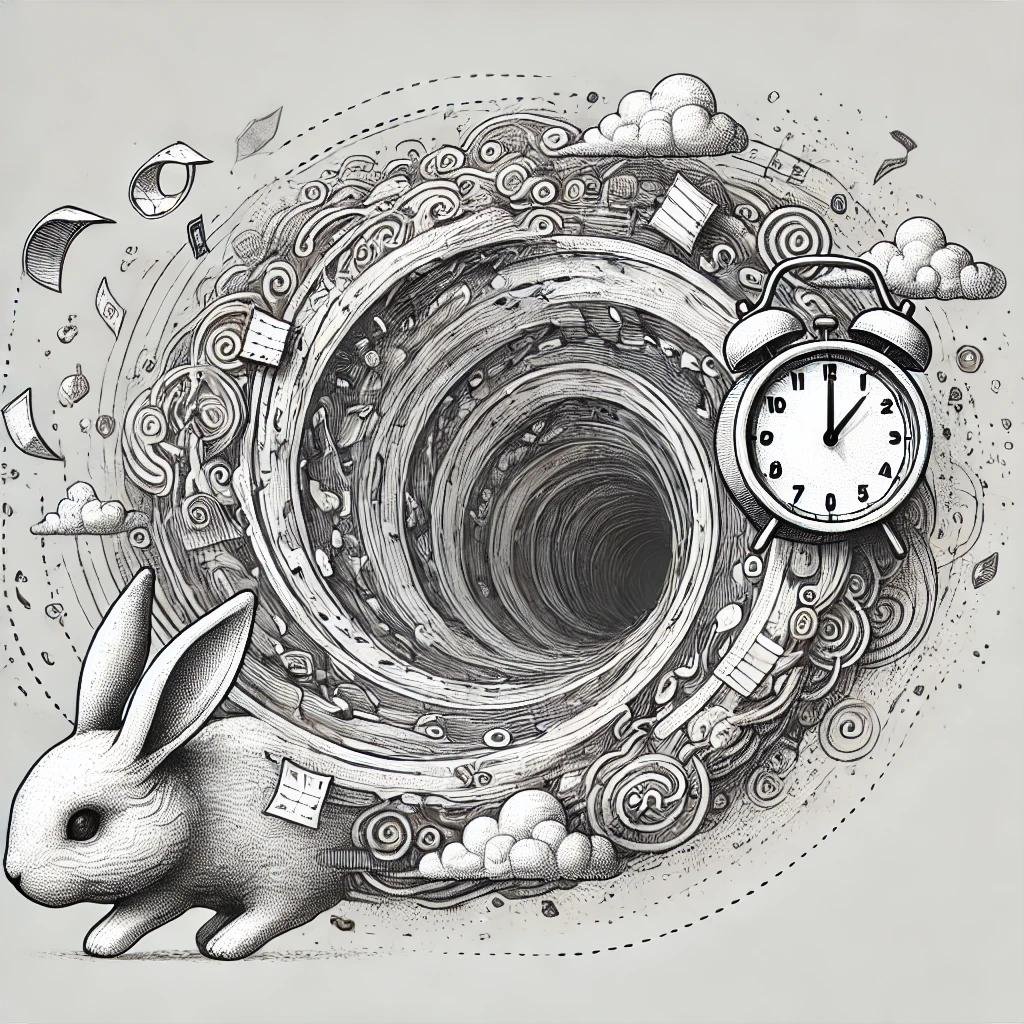Down the rabbit hole: The DMN trap for the ADHD brain
There’s something liberating about having no immediate external pressures—no meetings, no deadlines, just space to exist. But for someone with ADHD, that space can quickly turn into a black hole.
I knew this would happen. The Default Mode Network (DMN)—the part of the brain responsible for daydreaming, introspection, and self-referential thoughts—has always been my home. It’s where I piece together the mysteries of the universe, replay conversations from five years ago, and construct entire alternate realities in my head. But left unchecked, it doesn’t just wander—it spirals.
Even on walks, my thoughts drifted deeper and deeper into abstract rabbit holes, while somewhere in the background, a faint voice echoed: You’re running out of time. It wasn’t a helpful reminder; it was a growing sense of detachment, an awareness that the real world was slipping further away while my mind explored its own endless corridors.
Hyperactive DMN and Isolation
For neurotypical brains, the DMN and the Task-Positive Network (TPN) work like a seesaw—one activates when the other is at rest. You focus, then you reflect. In ADHD, that switch is faulty. The DMN stays hyperactive even when it shouldn’t, making it harder to transition into doing rather than thinking (Castellanos & Proal, 2012). Without external structure, the pull towards isolation became stronger. Emails? Ignored. Messages? Unread. Social interactions? Felt like climbing a mountain. The effort to engage felt unnatural, even when I knew it was necessary.
This isn’t just an ADHD thing. Overworking had already burned me out, and now, with all this newfound space, I was experiencing the opposite extreme—a full retreat inward.
Pattern Interrupt: Forcing the Shift
I knew what I had to do, but knowing doesn’t always mean doing. The only thing that worked? Pattern interrupt. Breaking the cycle before the spiral.
Uncomfortably making myself interact – Even when it felt forced, answering messages, replying to emails, and physically putting myself in situations where I had to engage helped reset the loop.
Grounding through movement – Walks were great, but passive. Adding small disruptions—changing routes, listening to something engaging, or actively looking around—kept me present rather than lost in thought.
Externalising priorities – Instead of keeping a mental backlog of things to do (which would inevitably pile up into an overwhelming mess), I wrote ‘to do’ lists every morning and found people to keep me accountable – even if it is repeating to a friend what I had to do – this creates a delicate pressure to get the ball rolling.
Quick Sleep Update: Structure is Helping
Another unexpected shift—my sleep. Since Day 0, adding magnesium and waking up at the same time has noticeably helped.
✔ Deeper sleep – No more shallow, fragmented rest.
✔ Less overstimulation – Falling asleep with less mental noise.
✔ Feeling more rested mentally – Not just physically, but cognitively lighter in the mornings.
✔ More stable energy throughout the day – The simple act of maintaining a consistent wake-up time has reduced the grogginess that used to drag into the afternoon.
I’m wondering if this ties into lowered sensory overload during the day. Magnesium plays a role in regulating the nervous system and reducing hyperactivity in the brain, which might be helping (Slutsky et al., 2010). But stabilising my wake-up time has likely reinforced my circadian rhythm, preventing the erratic energy crashes that ADHD often brings (Boonstra et al., 2007). It’s early days, but the shift is real.
What’s Next? A Deep Dive into the DMN
Tomorrow, I’ll get into why ADHD and the DMN are so closely linked, how it impacts focus, and what can be done about it.
Today was about recognising the pattern—tomorrow will be about breaking it for good.
Your Turn: Recognise your DMN loops
If you find yourself lost in thought, procrastinating, or avoiding engagement, try catching yourself in the act.
What’s one small pattern interrupt you can introduce today? - Maybe it’s answering that one message you’ve been avoiding, stepping outside for a short walk with intention, or simply writing down a task and acting on it immediately.
Let’s rewire.
References
Boonstra, A. M., Kooij, J. S., Oosterlaan, J., Sergeant, J. A., & Buitelaar, J. K. (2007). To act or not to act? Distinctions between motor inhibition, attention, and response control in adult ADHD. Journal of Neural Transmission, 114(7), 831-839. https://doi.org/10.1007/s00702-007-0688-2
Castellanos, F. X., & Proal, E. (2012). Large-scale brain systems in ADHD: Beyond the prefrontal–striatal model. Trends in Cognitive Sciences, 16(1), 17-26. https://doi.org/10.1016/j.tics.2011.11.007
Slutsky, I., Abumaria, N., Wu, L. J., Huang, C., Zhang, L., Li, B., & Zhao, X. (2010). Enhancement of learning and memory by elevating brain magnesium. Neuron, 65(2), 165-177. https://doi.org/10.1016/j.neuron.2009.12.026

